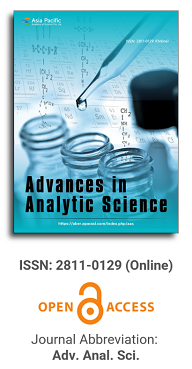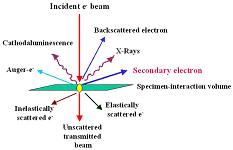
Asia Pacific Academy of Science Pte. Ltd. (APACSCI) specializes in international journal publishing. APACSCI adopts the open access publishing model and provides an important communication bridge for academic groups whose interest fields include engineering, technology, medicine, computer, mathematics, agriculture and forestry, and environment.

Mensuration of natural vitamin A in fish liver using liquid chromatography
Vol 4, Issue 2, 2023
Download PDF
Abstract
To mensurate the content of vitamin A (vitamin A1, vitamin A2) in fish liver accurately, methods of sample pretreatment (including water bath saponification, room temperature saponification, and direct extraction) and detection methods (including normal phase chromatography and reversed phase chromatography) were screened and applied to the mensuration of vitamin A in the liver of 9 economic fish species. The results revealed that by reversed phase chromatography vitamin A1 and vitamin A2 were effectively divided, and showed good linear relationship within their respective linear ranges (R2 > 0.99).The content of vitamin A extracted by water bath saponification was distinctly higher than the contentof Vitamin A by room temperature saponification and direct extraction (p < 0.05). Its average recovery rates of vitamin A1 and vitamin A2 were respectively 104.52% and 90.94%. The total content of vitamin A in the livers of other freshwater fishes and marine fishes except for the freshwater snakehead and big mouth bass was more than 200 μg/100 g, and the total content of vitamin A in the liver of marine giant grouper is 14,413.78 μg/100 g, among the result was the highest. The water bath saponification method with reversed phase chromatography has good precision and is suitable for the mensuration of vitamin A in fish liver.
Keywords
References
- Mason J, Greiner T, Shrimpton R, et al. Vitamin A policies need rethinking. International Journal of Epidemiology. 2014; 44(1): 283-292. doi: 10.1093/ije/dyu194
- Medeiros SR, Pinheiro-Rosa N, Lemos L, et al. Vitamin A supplementation leads to increases in regulatory CD4+Foxp3+LAP+ T cells in mice. Nutrition. 2015; 31(10): 1260-1265. doi: 10.1016/j.nut.2015.03.004
- Micronutrient deficiencies: vitamin A deficiency. Available online: https://apps.Who.Int/nutrition/topics/vad/en/index.HtmL (accessed on 28 June 2021)
- Herrero-Barbudo MC, Granado-Lorencio F, Blanco-Navarro I, et al. Retinol, α- and γ-tocopherol and carotenoids in natural and vitamin A- and E-fortified dairy products commercialized in Spain. International Dairy Journal. 2005; 15(5): 521-526. doi: 10.1016/j.idairyj.2004.07.011
- McGeeney BE, Friedman DI. Pseudotumor Cerebri Pathophysiology. Headache: The Journal of Head and Face Pain. 2014; 54(3): 445-458. doi: 10.1111/head.12291
- Gesto M, Castro LFC, Reis-Henriques MA, et al. Tissue-specific distribution patterns of retinoids and didehydroretinoids in rainbow trout Oncorhynchus mykiss. Comparative Biochemistry and Physiology Part B: Biochemistry and Molecular Biology. 2012; 161(1): 69-78. doi: 10.1016/j.cbpb.2011.09.006
- Lin C, Wu P, Tang X, et al. The development status of cod liver oil products in China. Existing problems and development strategies (Chinese). China Grease. 2021; 46(6): 21-24.
- Carlotti ME, Rossatto V, Gallarate M. Vitamin A and vitamin A palmitate stability over time and under UVA and UVB radiation. Int J Pharm. 2002; 240(1): 85-94.
- Riaz MN, Asif M, Ali R. Stability of Vitamins during Extrusion. Critical Reviews in Food Science and Nutrition. 2009; 49(4): 361-368. doi: 10.1080/10408390802067290
- Kamal Eldin A, Gorgen S, Pettersson J, et al. Normal-phase high-performance liquid chromatography of tocopherols and tocotrienols: comparison of different chromatographic columns. J Chromatogr A. 2000; 881(1): 217-227.
- Pharmacopoeia editorial board of the people’s Republic of China Pharmacopoeia of the people’s Republic of China. Beijing: China Medical Science and Technology Press; 2010.
- Rebeca C, Suana C. Direct analysis of vitamin A, vitamin E, carotenoids, chlorophylls and free sterols in animal and vegetable fats in a single normal-phase liquid chromatographic run. Journal of Chromatography A. 2018; 1565: 81-88. doi: 10.1016/j.chroma.2018.06.029
- Käkelä A, Käkelä R, Hyvärinen H. Importance of the kidneys in metabolism of vitamins A1 and A2 and their fatty acyl esters in mink feeding on fish-based diets and exposed to Aroclor 1242. Toxicol Appl Pharmacol. 2003; 187(2): 118-127.
- Enright JM, Toomey MB, Sato S ya, et al. Cyp27c1 Red-Shifts the Spectral Sensitivity of Photoreceptors by Converting Vitamin A1 into A2. Current Biology. 2015; 25(23): 3048-3057. doi: 10.1016/j.cub.2015.10.018
- Corbo JC. Vitamin A1/A2 chromophore exchange: Its role in spectral tuning and visual plasticity. Developmental Biology. 2021; 475: 145-155. doi: 10.1016/j.ydbio.2021.03.002
- Defo MA, Pierron F, Spear PA, et al. Evidence for metabolic imbalance of vitamin A2 in wild fish chronically exposed to metals. Ecotoxicology and Environmental Safety. 2012; 85: 88-95. doi: 10.1016/j.ecoenv.2012.08.017
- Liu B, Lang Z, Yin X, et al Determination of vitamin A in milk powder by high performance liquid chromatography. D. China dairy industry. 2003; 31(2): 36-38.
- Nimalaratne C, Sun C, Wu J, et al. Quantification of selected fat soluble vitamins and carotenoids in infant formula and dietary supplements using fast liquid chromatography coupled with tandem mass spectrometry. Food Research International. 2014; 66: 69-77. doi: 10.1016/j.foodres.2014.08.034
- Roos N, Chamnan C, Loeung D, et al. Freshwater fish as a dietary source of vitamin A in Cambodia. Food Chemistry. 2007; 103(4): 1104-1111. doi: 10.1016/j.foodchem.2006.10.007
- Zheng Y, Huang B, Ren Y. Simultaneous determination of eight vitamin E isomers and vitamin A in foods by normal-phase high performance liquid chromatography. Chinese Journal of Chromatography. 2016; 34(7): 692. doi: 10.3724/sp.j.1123.2016.02011
- Wen C, Hu Y, Zhou F, et al. Comparative study on Extraction of cactus seed oil by different methods. China grease. 2019; 44(8): 1-5.
- Jiang B, Hu W, Liu C, et al. Simultaneous determination of vitamin A and vitamin E in vegetable oil by HPLC. Food industry science and technology. 2015; 36(3): 320-323,334.
- Laboratory quality control specifications physical and chemical testing of food: GB/T 27404—2008. Beijing: China Standards Press; 2008.
- Kondrashev SL, Lamash NE. Unusual A1/A2-visual pigment conversion during light/dark adaptation in marine fish. Comparative Biochemistry and Physiology Part A: Molecular & Integrative Physiology. 2019; 238: 110560. doi: 10.1016/j.cbpa.2019.110560
- Liu N, Cui G, Yang L, et al. Effects of vitamin a level on antioxidant capacity and serum of laying hens in winter. Effect of vitamin a content in liver and eggs. Journal of animal nutrition. 2015; 27(7): 2209-2214.
- Lian X, Chen N, Wang M, et al. Vitamin a requirement of largemouth bass. Journal of animal nutrition. 2017; 29(10): 3819-3830.
Supporting Agencies
Copyright (c) 2023 Wenting Huang, Wenhong Cao, Chaohua Zhang, Xiaoming Qin, Jialong Gao, Huina Zheng

This work is licensed under a Creative Commons Attribution 4.0 International License.

This site is licensed under a Creative Commons Attribution 4.0 International License (CC BY 4.0).
1.jpg)
Prof. Sivanesan Subramanian
Anna University, India





.jpg)
